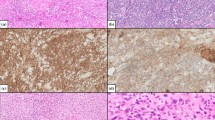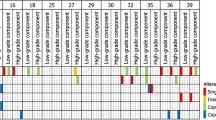Abstract
Background
The occurrence of p53 loss of heterozygosity (LOH) is a common genetic event in malignancy. LOH occurs when a heterozygous locus loses one of its two parental alleles, becoming homozygous at that locus, by either copy number loss (CNL-LOH) or by becoming copy number neutral (CNN-LOH). A role for CNL-LOH (cnLOH) has been postulated in cancer aetiology. Loss of heterozygosity (LOH) results in irreversible genetic loss.
Aims
LOH was determined in DNA extracted from formalin-fixed paraffin-embedded (FFPE) leiomyosarcoma (LMS) specimens in a retrospective study from 30 patients, to assess the prognostic significance of LOH. The findings were analysed and their validity assessed. LOH was an adverse prognostic factor in LMS. Prospective uniform standardisation of formalin-fixation techniques is required.
Methods
DNA was extracted from 169 formalin-fixed paraffin blocks of 30 patients with LMS, following extensive tissue microdissection. Genomic DNA was amplified using the polymerase chain reaction (PCR) technique. Fluorescence-based microsatellite PCR was used to detect and quantitate heterozygosity loss.
Results
LOH was detected at gene locus 17p13 in 16 LMS (Four grade 2 and 12 grade 3 LMS). LOH was not detected in 14 LMS cases (one grade 1, five grade 2 and eight grade 3 LMS). LOH was associated with shorter patient survival.
Conclusions
The results reported herein endorse the value of utilizing FFPE DNA in identifying LOH as a prognostic factor in LMS. The results have implications for tumour biobanking and precision medicine in patients with sarcomas.


Similar content being viewed by others
Data Availability
Determination of growth fractions and use of refined PCR techniques to detect mutations and allelic loss of p53 in paraffin-embedded synovial sarcoma and leiomyosarcoma’ John N McMahon MD Thesis, University College Dublin (UCD) 2022: Chapter 5: PCR-LOH: pp206-209; Chapter 7: Variability of LOH findings in microdissected formalin-fixed paraffin embedded (FFPE) DNA: pp 241-256; pp 269-274. Cox proportional hazards model for Leiomyosarcoma: p365-366.
References
Enzinger FM, Weiss SW (2019) Soft Tissue Tumors. Elsevier, USA
Xue MF, Chen G, Dai JP et al (2019) Development and validation of a prognostic nomogram for extremity soft tissue leiomyosarcoma. Front Oncol. https://doi.org/10.3389/fonc.2019.00346.Accessed01May2019
Guo X, Jo VY, Mills AM et al (2015) Clinically relevant molecular subtypes in leiomyosarcoma. Clin Cancer Res 21:3501–3511. https://doi.org/10.1158/1078-0432.CCR-14-3141
Bunz F, Vogelstein B (2018) Cancer Genetics. In: Jameson, Fauci, Kasper ‘et al’(eds) Harrison’s Principles of Internal Medicine, 20th edn. McGraw-Hill Education, USA, pp 452–60
Zhang X, Sjöblom T (2021) Targeting loss of heterozygosity: a novel paradigm for cancer therapy. Pharmaceuticals (Basel) 14:57. https://doi.org/10.3390/ph14010057
Bunz F, Vogelstein B (2018) Cancer Genetics. In: Jameson, Fauci, Kasper et al. (eds) Harrison’s Principles of Internal Medicine, 20th edn. McGraw-Hill Education, USA, pp 455
Vogelstein B, Papadopoulos N, Velculescu VE et al (2013) Cancer Genome Landscapes. Science 339:1546–1558. https://doi.org/10.1126/science.1235122
Tapial S, Garcia JL, Corchete L et al (2020) Copy neutral loss of heterozygosity (cnLOH) patterns in synchronous colorectal cancer. Eur J Hum Genet 29:709–713. https://doi.org/10.1038/s41431-020-00774-w
Lee GT, Chung YJ (2022) Comparison of the copy-neutral loss of heterozygosity identified from whole-exome sequencing data using three different tools Genom Inform 20:e4. https://doi.org/10.5808/gi.21066
Gaffney EF, Dervan PA, McCabe MM et al (1994) Soft tissue and visceral sarcomas in Irish patients. Ir J Med Sci 163:240–245. https://doi.org/10.1007/BF02973397
Bass BP, Engel KB, Greytak SR et al (2014) A review of preanalytical factors affecting molecular, protein, and morphological analysis of formalin-fixed, paraffin-embedded (FFPE) tissue: how well do you know your FFPE specimen? Arch Pathol Lab Med 138:1520–1530. https://doi.org/10.5858/arpa.2013-0691-RA
Shi SR, Key ME, Kaira KL (1991) Antigen retrieval in formalin-fixed, paraffin-embedded tissues: an enhancement method for immunohistochemical staining based on microwave oven heating of tissue sections. J Histochem Cytochem 39:741–748. https://doi.org/10.1177/39.6.1709656
Pan LX, Diss TC, Peng HZ et al (1994) Clonality analysis of defined B-cell populations in archival tissue sections using microdissection and the polymerase chain reaction. Histopath 24:323–327. https://doi.org/10.1111/j.1365-2559.1994.tb00532.x
Goelz SE, Hamilton SR, Vogelstein B (1985) Purification of DNA from formaldehyde fixed and paraffin embedded human tissue. Biochem Biophys Res Commun 130:118–126. https://doi.org/10.1016/0006-291x(85)90390-0
Cawkwell L, Bell SM, Lewis FA et al (1993) Rapid detection of allele loss in colorectal tumours using microsatellites and fluorescent DNA technology. Br J Cancer 67:1262–1267. https://doi.org/10.1038/bjc.1993.236
Cawkwell L, Lewis FA (1994) Quirke, P (1994) Frequency of allele loss of DCC, p53, RBI, WTI, NFI, NM23 and APC/MCC in colorectal cancer assayed by fluorescent multiplex polymerase chain reaction. Br J Cancer 70:813–818. https://doi.org/10.1038/bjc.1994.404
Cawkwell L, Li D, Lewis FA et al (1995) Microsatellite instability in colorectal cancer: Improved assessment using fluorescent polymerase chain reaction. Gastroenterology 109:465–471. https://doi.org/10.1016/0016-5085(95)90334-8
Jones MH, Nakamura Y (1991) Detection of loss of heterozygosity at the human TP53 locus using a dinucleotide repeat polymorphism. Genes Chrom Cancer 5:89–90. https://doi.org/10.1002/gcc.2870050113
Kellogg DE, Rybalkin I, Chen S et al (1994) TaqStart Antibody: hot start PCR facilitated by a neutralizing monoclonal antibody directed against Taq DNA polymerase. Biotechniques 16:1134–1137. (PMID: 8074881)
Gruis NA, Abeln EC, Bardoel AF et al (1993) PCR-based microsatellite polymorphisms in the detection of loss of heterozygosity in fresh and archival tumour tissue. Br J Cancer 68:308–313. https://doi.org/10.1038/bjc.1993.333
Harrington DP, Fleming TR (1982) A class of rank test procedures for censored survival data. Biometrika 69:553–566. https://doi.org/10.2307/2335991
Cox DR (1972) Regression models and life-tables. J Royal Statistical Soc Series B:Methodological 34: 187–220. https://rss.onlinelibrary.wiley.com/doi/abs/10.1111/j.2517-6161.1972.tb00899.x
Venables WN, Ripley BD (2002) Modern Applied Statistics with S: Springer-Verlag, New York
Kaplan EL, Meier P (1958) Nonparametric estimation from incomplete observations. J Am Statist Assoc 53:457–481. https://doi.org/10.1080/01621459.1958.10501452
Li FP, Fraumeni JF, Mulvihill JJ et al (1988) A cancer family syndrome in twenty-four kindreds. Cancer Res 48:5358–5362 (PMID: 3409256)
Batalini F, Peacock EG, Stobie L et al (2019) Li-Fraumeni syndrome: not a straightforward diagnosis anymore – the interpretation of pathogenic variants of low allele frequency and differences between germline PVs, mosaicism, and clonal hematopoiesis. Breast Cancer Res 21:107. https://doi.org/10.1186/s13058-019-1193-1
Chang SC, Lin JK, Lin TC et al (2005) Loss of heterozygosity: an independent prognostic factor of colorectal cancer. World J Gastroenterol 11:778–784. https://doi.org/10.3748/wjg.v11.i6.778
Jia X, Shanmugam C, Paluri RK et al (2017) Prognostic value of loss of heterozygosity and sub-cellular localization of SMAD4 varies with tumor stage in colorectal cancer. Oncotarget 8:20198–20212. https://doi.org/10.18632/oncotarget.15560
Soaresa EWS, Santos SCdeL, Bueno AG et al (2010) Concomitant loss of heterozygosity at the BRCA1 and FHIT genes as a prognostic factor in sporadic breast cancer. Cancer Genet Cytogenet 199:24–30. https://doi.org/10.1016/j.cancergencyto.2010.01.019
Tseng RC, Chang JW, Hsien FJ et al (2005) Genomewide loss of heterozygosity and its clinical associations in non small cell lung cancer. Int J Cancer 117:241–247. https://doi.org/10.1002/ijc.21178
Høgdall EVS, Ryan A, Kjaer SK et al (2004) Loss of heterozygosity on the X chromosome is an independent prognostic factor in ovarian carcinoma. Cancer 100:2387–2395. https://doi.org/10.1002/cncr.20213
Grundy PE, Breslow NE, Li S et al (2005) Loss of heterozygosity for chromosomes 1p and 16q is an adverse prognostic factor in favorable-histology Wilms tumor: a report from the National Wilms Tumor Study Group. J Clin Oncol 23:7312–7321. https://doi.org/10.1200/JCO.2005.01.2799
Pyke RM, Abbott C, Dea S et al (2021) Association of HLA loss of heterozygosity with allele-specific neoantigen expansion in response to immunotherapy. J Clin Oncol 39, (suppl 15) published online May 28. https://doi.org/10.1200/JCO.2021.39.15_suppl.e18030
Kim J, Kim JH, Kang HG et al (2018) Integrated molecular characterization of adult soft tissue sarcoma for therapeutic targets. BMC Med Genet 19(suppl 1):216. https://doi.org/10.1186/s12881-018-0722-6
Nichols CA, Gibson WJ, Brown MS et al (2020) Loss of heterozygosity of essential genes represents a widespread class of potential cancer vulnerabilities. Nat Commun 11:2517. https://doi.org/10.1038/s41467-020-16399-y
Alexandrova EM, Mirza SA, Xu S et al (2017) p53 loss-of-heterozygosity is a necessary prerequisite for mutant p53 stabilization and gain-of-function in vivo. Cell Death Dis 8:e2661. https://doi.org/10.1038/cddis.2017.80
Hwang MS, Moga BJ, Douglass J et al (2021) Targeting loss of heterozygosity for cancer-specific immunotherapy. PNAS 118: e2022410118. https://doi.org/10.1073/pnas.2022410118
Do H, Dobrovic A (2015) Sequence artifacts in DNA from formalin-fixed tissues: causes and strategies for minimization. Clin Chem 61:64–71. https://doi.org/10.1373/clinchem.2014.223040
Robbe P, Popitsch N, Knight SJL et al (2018) Clinical whole-genome sequencing from routine formalin-fixed, paraffin-embedded specimens: pilot study for the 100,000 genomes project. Genet Med 20:1196–1205. https://doi.org/10.1038/gim.2017.241
Gaffney EF, Riegman PH, Grizzle WE et al (2018) Factors that drive the increasing use of FFPE tissue in basic and translational cancer research. Biotech Histochem 93:373–386. https://doi.org/10.1080/10520295.2018.1446101
Einaga N, Yoshida A, Noda H et al (2017) Assessment of the quality of DNA from various formalin-fixed paraffin-embedded (FFPE) tissues and the use of this DNA for next-generation sequencing (NGS) with no artifactual mutation. PloS One 12:e0176280. https://doi.org/10.1371/journal.pone.0176280
Ramon y Cajal S, Sesé M, Capdevila C et al (2020) Clinical implications of intratumor heterogeneity: challenges and opportunities. J Mol Med 98:161–177. https://doi.org/10.1007/s00109-020-01874-2
Degl’Innocenti A, di Leo N, Cioifani G (2020) Genetic hallmarks and heterogeneity of glioblastoma in the single-cell omics era. Adv Ther (Weinh) 3:1900152. https://doi.org/10.1002/adtp.201900152
Acknowledgements
Dr McMahon wishes to acknowledge the significant theoretical and technical contributions of Professor R McManus (TCD), and supervision by Professor, NA Parfrey (UCD) and Professor D Croke (RCSI). The guidance of Dr. P Kelehan (National Maternity Hospital Dublin), Professor PA Daly (St James’s Hospital Dublin), and Professor PA Dervan (UCD, deceased) is gratefully acknowledged.
Funding
This work was supported by grants from The Irish Cancer Society, The Health Research Board (Ireland) in 1992–1994, and by Trinity College Dublin, by the Histopathology Department in University College, Dublin, and by the Department of Biochemistry, Royal College of Surgeons in Ireland in 1993–1995.
Author information
Authors and Affiliations
Contributions
JNMcM1 performed PCR experiments, analysed the data, wrote and presented the manuscript, EFG2 contributed to data analyses and paper presentation, WJA-K3 performed digital imaging and contributed to paper presentation, JFS1 performed polymerase chain reaction experiments, AJ4 performed the statistical analysis, BC5 performed polymerase chain reaction and heterozygosity analysis. All named authors made significant accountable contributions to the conception, design, accuracy, paper integrity and to the acquisition, analysis and interpretation of data used, resulting in the final version of this work for publication. The authors wish to state that there is no conflict of interest.
Corresponding author
Ethics declarations
Ethical statement
All 30 patients gave informed consent to provide clinical treatment and subsequent follow-up details to their clinical consultant and to have their data coordinated centrally in a dedicated database by a research assistant appointed by grants from The Irish Cancer Society. Ethical approval from Irish Research and Ethics Committees for research that posed only a negligible risk to patients, was not required. Selected specific additional patient data, including survival data, was obtained from medical records and then fully anonymised. There was no patient or public involvement in the design phase or logistics of this project or at any stage during the project itself. No additional data is available.
Additional information
Publisher's Note
Springer Nature remains neutral with regard to jurisdictional claims in published maps and institutional affiliations.
Rights and permissions
Springer Nature or its licensor (e.g. a society or other partner) holds exclusive rights to this article under a publishing agreement with the author(s) or other rightsholder(s); author self-archiving of the accepted manuscript version of this article is solely governed by the terms of such publishing agreement and applicable law.
About this article
Cite this article
McMahon, J.N., Gaffney, E.F., Aliaga-Kelly, W.J. et al. P53 loss of heterozygosity (LOH) in formalin-fixed paraffin-embedded leiomyosarcoma (LMS): a novel report. Ir J Med Sci 193, 65–71 (2024). https://doi.org/10.1007/s11845-023-03370-1
Received:
Accepted:
Published:
Issue Date:
DOI: https://doi.org/10.1007/s11845-023-03370-1




